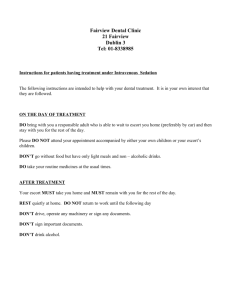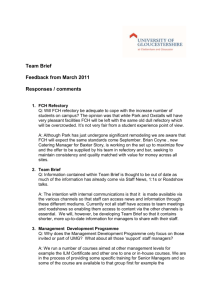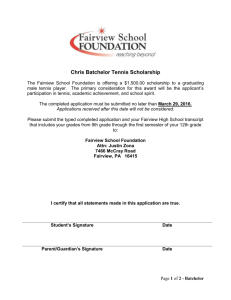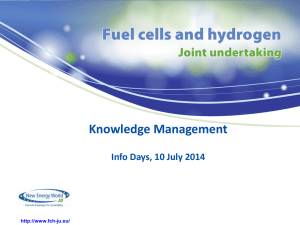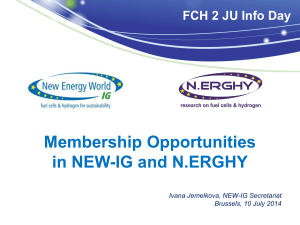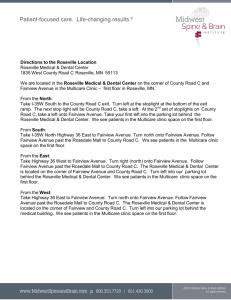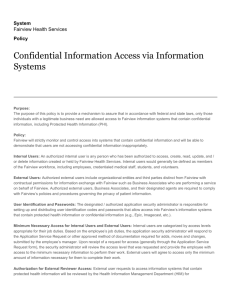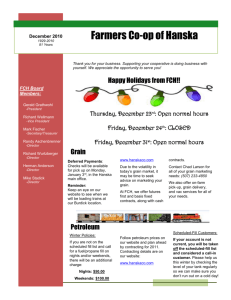Fairview Community Health Community Engagement and Needs
advertisement
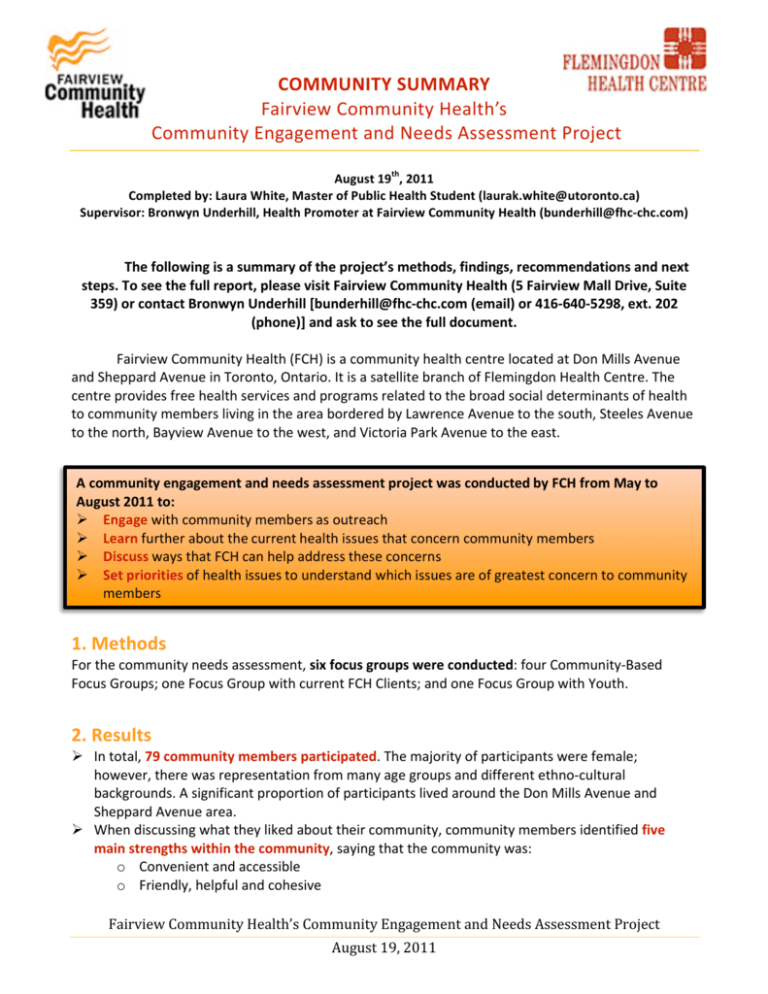
1 COMMUNITY SUMMARY Fairview Community Health’s Community Engagement and Needs Assessment Project August 19th, 2011 Completed by: Laura White, Master of Public Health Student (laurak.white@utoronto.ca) Supervisor: Bronwyn Underhill, Health Promoter at Fairview Community Health (bunderhill@fhc‐chc.com) The following is a summary of the project’s methods, findings, recommendations and next steps. To see the full report, please visit Fairview Community Health (5 Fairview Mall Drive, Suite 359) or contact Bronwyn Underhill [bunderhill@fhc‐chc.com (email) or 416‐640‐5298, ext. 202 (phone)] and ask to see the full document. Fairview Community Health (FCH) is a community health centre located at Don Mills Avenue and Sheppard Avenue in Toronto, Ontario. It is a satellite branch of Flemingdon Health Centre. The centre provides free health services and programs related to the broad social determinants of health to community members living in the area bordered by Lawrence Avenue to the south, Steeles Avenue to the north, Bayview Avenue to the west, and Victoria Park Avenue to the east. A community engagement and needs assessment project was conducted by FCH from May to August 2011 to: Engage with community members as outreach Learn further about the current health issues that concern community members Discuss ways that FCH can help address these concerns Set priorities of health issues to understand which issues are of greatest concern to community members 1. Methods For the community needs assessment, six focus groups were conducted: four Community‐Based Focus Groups; one Focus Group with current FCH Clients; and one Focus Group with Youth. 2. Results In total, 79 community members participated. The majority of participants were female; however, there was representation from many age groups and different ethno‐cultural backgrounds. A significant proportion of participants lived around the Don Mills Avenue and Sheppard Avenue area. When discussing what they liked about their community, community members identified five main strengths within the community, saying that the community was: o Convenient and accessible o Friendly, helpful and cohesive Fairview Community Health’s Community Engagement and Needs Assessment Project August 19, 2011 2 o Filled with many great resources and programs o Safe and quiet o Diverse and multicultural “I feel lucky to live here” ‐ Participant In the client focus group, most participants spoke about how they liked specific FCH programs and services, finding the centre to be very helpful, providing them with health information and ways to get to know other people. As an activity to help encourage participants to think about health, and their health, participants were divided into groups and asked to complete the sentence: “I know I am healthy when …”. Participants were encouraged to consider all aspects of health when responding to the sentence, and to draw, write and brainstorm with others in their group. Figure 1 displays examples from this activity. Figure 1. Products from “I know I am healthy when …” activity Community members discussed health problems found within the community, with the majority of issues relating to challenges associated with: o The health care system o Time management and balancing competing pressures o Finances and employment o Food and nutrition Fairview Community Health’s Community Engagement and Needs Assessment Project August 19, 2011 3 Community members also identified programs, that would help improve their personal, families’ and community’s health, and that they would like to see offered at Fairview Community Health. They were asked to select the top three programs that they wanted FCH to initially focus on, and start working on right away. The selected programs are listed below. Priority Programs Identified by Community Members 1. 2. 3. 4. 5. 6. (Ordered from most to least preferred) Low cost or free dental care for uncovered individuals Fitness and recreational programs • Several fitness and recreational programs were priority areas for community members, including: o Yoga, meditation, dancing and exercise classes, such as ones focusing on specific diseases or areas of the body. • Improving the quality and increasing the hours of operation of swimming pools o One focus group discussed the need for a women’s‐only pool or swim program. Programming for children and youth, including: • Arts, music, sports, tutoring and other afterschool programs • A program around health for teenagers • Childcare More Farm Trips and Family Activities • Both increasing the number of farm trips and holding the trips on weekends were emphasized. Participants also asked for field trips to other locations. Health care outside of the clinic, such as: • A health helpline, where community members could speak with someone about their health concerns and could get these addressed, as well as be directed to resources and services in the area. • An after‐hours, urgent care, walk‐in, or 24‐hour clinic Skills Programs, including: • French and Other Languages Classes • Employable Skills for Women Workshops • Volunteer Programs • First Aid and CPR Certification Courses Fairview Community Health’s Community Engagement and Needs Assessment Project August 19, 2011 4 Priority Programs Continued … 7. Mental health programming • A campaign raising awareness around mental health, and stress management classes, were both identified as priority programs in two different focus groups. • Community members discussed the need for further counseling at FCH, either through a psychologist or a psychiatrist. 8. Other priority areas, including: • Low cost or free eye care for seniors • Programs for community members over the age of 50 Participants were asked about what would help them come to use the health centre’s services and programs. A variety of suggestions were given, and are grouped under the major themes below. Supports to help Community Members attend FCH: Enhance Communicadon and Outreach In every focus group, parVcipants discussed the need for improved communicaVon and outreach. • Community members suggested using a variety of methods, including emails, flyers and the centre’s website, to promote the health centre and its programs and services. • Community members suggested translaVng brochures, posVng flyers and promoVng the centre at LINC and ESL classes, as well as at schools. • PromoVng FCH’s benefits as a CHC and an alternaVve to the tradiVonal models of medical care was recommended as a strategy for FCH to use. Offer programs and services in other languages ‐ ParVcipants in all focus groups indicated that offering services and programs (parVcularly ones using medical terms) in the first languages of community members would help enable them to use the services and programs at the health centre. ‐ AddiVonally, translaVng brochures and other informaVon would help more people learn about Fairview Community Health, and health informaVon. Fairview Community Health’s Community Engagement and Needs Assessment Project August 19, 2011 5 More diverse hours from programs and services Community members asked for programs and services to be offered a]er school, and in the evenings, on Saturday, and on holidays. • Offering all programs and services on Saturdays was the client focus group’s first priority program, when asked to indicate the area that they wanted FCH to focus on first. ConVnued connecVon with the community ‐ Community members expressed appreciaVon for the focus groups and indicated that Fairview Community Health should conVnue with their willingness to serve the community, accept feedback, and help the community members build community spirit. ‐ Community members wanted Fairview Community Health to act as an informaVon hub, where community members could come to find out about acVviVes and services within the community. The youth focus group identified programs and services that young people would like to see offered within the community, and at FCH. The top three programs selected by youth participants were (in order): Priority Programs for Youth 1. Anonymous HIV testing, sex, drug and alcohol clinics, and safe sex classes 2. Help with money and employment (finding jobs, workshops on job skills and workers’ rights) 3. Survival club for the wilderness Fairview Community Health’s Community Engagement and Needs Assessment Project August 19, 2011 6 The participants also indicated methods for reaching out to youth, and informing them about programs. Youth Outreach Methods included: Connect with schools Use Social Media • Make announcements at schools, and on the school websites • Use schools' email list‐servs • Connect with the guidance office at schools • Visit schools to discuss programs • Use Facebook, email, texts and twicer Outreach at Libraries • Place flyers and posters at libraries • Youth indicated that many community members, parVcularly newcomers, use the libraries to learn about volunteer and community opporuniVes and events. Be creaVve • The website, flyers and promoVonal materials should be visually exciVng and interesVng. Suggestions on Features of Youth Programs: Involve different Youth Led (Program leader acdvides and should be a youth) field trips Offer volunteer hours (good incenVve for parVcipaVon) Have snacks! Elements to include in youth programs Consider different dmes for programs • A]erschool programs are good, but should include homework Vme • Weekends may be becer for university students • Most youth agreed summer programs were great, because there was more free Vme Fairview Community Health’s Community Engagement and Needs Assessment Project August 19, 2011 7 3. Recommendations One of the purposes of the project was to inform FCH’s programs, services and future actions. The following section outlines the recommendations from the project, arranged into three areas: Program Planning; Communication and Outreach; and Partnerships and Advocacy. Within each area, the recommendations are grouped either under ‘establish’ (start at FCH), or ‘enhance’ (continue and improve at FCH). FCH has made specific commitments to working on these recommendations. Next to each recommendation are the corresponding action areas that have been discussed, and committed to, by FCH staff. These action areas are categorized according to: ‘Immediate plans’: Plans that have been decided upon and will take place ‘Explore’: Ideas and options that will be considered to determine what is feasible ‘Explore Partnerships’: Potential partnerships that should be explored, and established partnerships that should be enhanced, to address specific issues Many of these action areas involved exploring different ideas and options to address the health concerns and suggestions made by community members. PROGRAM PLANNING Recommendation Action Areas ESTABLISH 1. Diversify hours of operation at FCH (including afterschool, evenings and weekends). 2. Consider walk‐in clinic option or establish an intake counselor that can address community members’ questions and direct them to services and resources. Immediate Plans: Reorganize and update resource wall within FCH. Explore: Different methods of intake. Idea of posting locations of 24‐hour and walk‐in clinics in Fairview Community Health’s lobby, and including in voicemail message after hours. Promoting after‐hours care (on‐call services) provided through Flemingdon Health Centre. Fairview Community Health’s Community Engagement and Needs Assessment Project August 19, 2011 8 3. Set up youth priority programs. Immediate Plans: Include Youth Member on Advisory Board, or Establish 'Youth Task Force' to advise on FCH's operations, programs and services. Explore: Speak with Toronto Public Health and other agencies to determine feasibility of setting up Sexual and Reproductive Health, and Drugs Clinic. Idea of Interfaith Program (connect with religious organizations in the community to discuss idea and feasibility). ENHANCE 4. Set up more children’s programming. Immediate Plans: Currently, there are parenting programs offered in partnership with Toronto Public Health, and Speech and Language Programs offered on site. 5. Provide more space, and time, for social networking and events. 6. Enhance family programming. 7. Run more programming around: • Yoga and fitness • Women and seniors Immediate Plans: Fairview Community Health is committed to running a women’s group, with yoga, on a weekly basis in the fall, ensuring more continued programming for women. 8. Run education and skills workshops periodically. Immediate Plans: The Local Immigration Project is currently organizing a volunteer program for community members to develop their skills in their ‘Civic Engagement Working Group’. 9. Enhance Mental Health Programming. Explore: Idea of Mental Health Month 10. Enhance food and nutrition programs. Fairview Community Health’s Community Engagement and Needs Assessment Project August 19, 2011 9 COMMUNICATION AND OUTREACH Recommendation Action Areas ESTABLISH 1. Translate FCH flyers and health information into other languages. Immediate Plans: New outreach materials are being developed, and will be translated into Farsi and Mandarin. 2. Establish communication strategies to keep clients of FCH informed and involved: • Example: Email Listserv, Facebook and other social media tools, FCH’s website. 3. Work with community animators or peer health ambassadors that belong to the male, youth, senior and LGBTQ communities. Immediate Plans: FCH is an established positive space for all community members. There is a Positive Space poster displayed in FCH’s lobby. Explore Partnerships with: Access Alliance and Griffin Centre to assist with outreach to LGBTQ community members. ENHANCE 4. Provide programs in other languages. Enhance interpretation services. Immediate Plans: Peer Health Ambassadors Program at FCH will enable programs to be provided in other languages. 5. Continue to work with community members to conduct outreach. Immediate Plans: FCH has already started discussing partnership and outreach strategies with schools and libraries in the area. 6. Continue to connect with community Explore: members to receive their input on FCH will be involved with Flemingdon Health programs and services, and to get their Centre’s next client feedback survey. This feedback. survey will be an important mechanism to get feedback from clients. Fairview Community Health’s Community Engagement and Needs Assessment Project August 19, 2011 10 PARTNERSHIPS AND ADVOCACY Recommendation Action Areas ESTABLISH 1. Work with Toronto Public Health’s Dental Program, and Dental Hygienist Schools to develop strategies for providing lower cost or free dental care for community members that are not covered. Immediate Plans: Speak with manager of Dental Health Unit that works with Fairview Community Health. Set up resources on dental health and care at FCH front desk for community members. 2. Work with community agencies to establish another urgent care clinic, particularly for children, or links to urgent care clinic. Explore: Idea of Mobile ‘Community Info Sessions’: Idea of Walk‐in Clinic with Fairview Interagency Network. 3. Work with City of Toronto’s Parks and Recreation to develop fitness and recreational programs. 4. Work with CCAC and other community services around seniors’ supports (home care, eye care, etc.) ENHANCE 5. Work with other community agencies Immediate Plans: and community health centres around The Health Promoter at FCH is the current co‐ key structural health issues, such as chair of the Fairview Food Security Network dental coverage and waiting period for and the Community Health Centre Food OHIP. Security Network. 6. Collaborate with childcare agencies to provide more childcare options and affordable programs. Immediate Plans: The Local Immigration Project is currently exploring this issue in their ‘Health Working Group’. Explore Partnerships with: Seneca College’s Early Childhood Education Program. Fairview Community Health’s Community Engagement and Needs Assessment Project August 19, 2011 11 7. Work with food banks, Meals on Wheels, and breakfast clubs in the area to address food insecurity issues identified. 8. Connect with North York General Hospital to discuss issues and experiences of community members at the hospital. 4. Conclusion This project was small in scale; however, it managed to meet the objectives set out. The project helped to engage with community members so they could learn further about FCH, as well as to identify health issues affecting community members and the specific programs and services that could address these concerns. Fairview Community Health staff members are committed to exploring different ideas to address the issues identified within this assessment, and the recommendations outlined above. Change will take time, and will require the continued involvement of, and feedback from, community members, as well as sustained commitment from FCH staff. 5. Acknowledgements The author would like to acknowledge and thank the community members that participated in the project for their involvement and feedback, as well as the community animators for their hard work and input in the project. Special thanks are also given to Bronwyn Underhill, Suzanne Jackson and Shobha Oza for their support and guidance, as well as the staff of Fairview Community Health for their encouragement and commitment to this project, engaging with community members and responding to the findings. Thank you also to MPP David Caplan and Councillor Shelley Carroll for their support and contributing to the project. Finally, the author would like to acknowledge and thank the following organizations that provided financial, and in‐kind donations to the project: Toronto Public Libraries Ontario Science Centre Shoppers Drug Mart at Fairview Mall SilverCity Fairview Mall Cinemas Bruno’s Valu‐Mart at 33 Underhill Drive Food Basics at 1277 York Mills Road Tim Hortons (2501 Victoria Park Avenue and 2075 Sheppard Avenue East Locations) This project would not have been possible without their support. Fairview Community Health’s Community Engagement and Needs Assessment Project August 19, 2011
